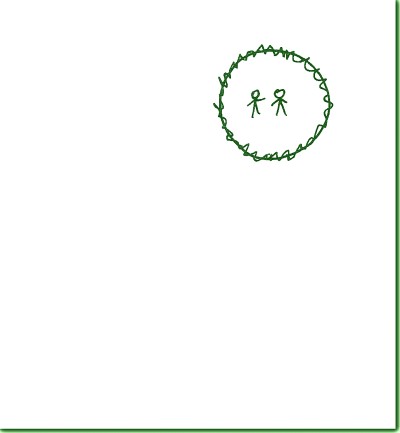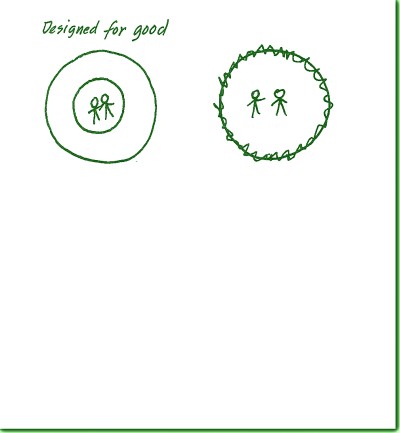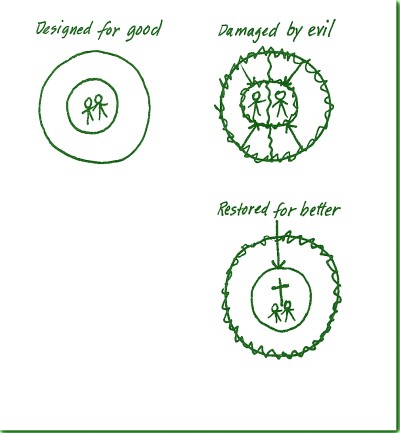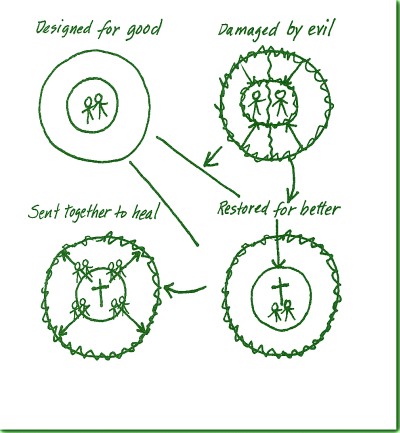James Choung, graduate of MIT, later serving as divisional director for InterVarsity Christian Fellowship in San Diego, set out to help college students explain the gospel to their friends. He turned to the most beloved tool in an engineer's arsenal: the diagram. He wanted a drawing -- simple enough to fit on a napkin -- that communicated the whole of Jesus' message or what Choung calls the "Big Story" -- that we are called to follow Jesus and let him make us "fishers of men" and to pray and labor for God's Kingdom, the community where what God wants to happen actually does.
Choung realized that few of his students would end up sharing the "transformational, communal and missional aims of the Gospel" with their friends unless they were given some tool or aid that would help them remember this bigger picture. So he created the diagram of four circles shown below.
In early 2008 he placed a PDF booklet on his website (www.jameschoung.net) explaining the diagram and saying: "Any feedback to improve this diagram is welcome." In Fall 2008 I taught Choung's diagram to an adult Sunday school class. Below is a revision coming from that interaction. The diagram is unchanged, but some wording of the script, particularly for the third and fourth circles, is new. (For the third circle, the cross is now in the center of the script as well as the diagram.)
--Harold Miller
www.interactingwithJesus.org
The Big Story: A Gospel Presentation
Preface: A new Gospel presentation is needed
Our most popular Gospel summaries (eg. the bridge diagram1) have been effective in the past and have touched many lives. But unfortunately they communicate only a small part of Jesus' message2. And in today's culture they are presentations that often feel increasingly arbitrary3 and irrelevant4.
The Big Story diagram hopes to be, as Einstein put it, "as simple as possible, but not simpler." It's a visual way to present a more holistic picture of our faith's central message, and hopefully may change the way we Christians think about the Gospel itself as well. The diagram shifts the spotlight in three areas to present Jesus' compelling message more fully. (Note: the items on the left aren't wrong, but they need to be balanced with the values on the right.)
Decision → Transformation5
Individual → Communal6
After-life → Mission-life7
This article is designed to be a teaching tool to present this diagram. The words in a normal font are things you might say. Instructions on how to draw the diagram are in green italics. One sentence summary statements are in bold. (Words in brown show -- on mouseover -- additional comments in a floating box.) But please don't feel like you have to memorize a script. Feel free to tailor or change this presentation according to your needs.
In the end, diagrams don't save people -- the Spirit does. And this diagram can't replace a community that credibly lives out the teachings of Jesus. But I hope this diagram does help us share the right message, and also allows us to feel better about the good news we share. Because it's not meant just to be good news for us, but also good news for the world.
--James Choung (shortened and adapted)

|
Would you like to hear the core message of Jesus or the basic storyline of the Bible?
In the upper right-hand corner draw a circle (representing the world) and two stick figures within it, slightly apart.What's our world like? What do you see on the news?9
Then we agree that the world is messed up?
Draw a squiggly line over the outer circle to represent a world in damage and shock.The world is messed up; that's obvious. But what's more interesting is the human response: how do you feel about this kind of world? (Answers might be "sad" or "angry" or "don't care." Listen and interact.)
No normal person thinks that suffering, violence and oppression are good things. No one throws a party for a bloodbath in Darfur, when a child is infected with AIDS, or when the Towers fell in New York.
So what does this suggest? Most people ache for a better world. Our universal ache speaks of something more. Just like hunger points to food and thirst points to water, so our universal ache for a better world means that such a world either once existed or will one day exist.

|
Draw a new circle in the top left corner representing the world, but no squiggly lines. Draw people, who are not necessarily Adam and Eve, close together to represent intimacy and community.In the Christian worldview10, God created a good, wonderful world. In the beginning, everything was right with everything else.
Us and the world. Creation (our environment) was designed to take care of us and we were designed to take care of creation. We were made to be interdependent. Gen 1:29-30 2:15
Us and each other. People were designed to take care of each other. They were made to be in true community, with the freedom to love and be loved, to serve and be served, to be themselves without shame in front of each other. Gen 2:25
Us and God. Each person was designed to be in a relationship with the God, one full of love and intimacy. God hung out with us, and we liked being with him. We were meant to love and serve each other. Gen 3:8
Draw the inner circle to represent God's presence with us.The world and all that's in it was designed for good.
Write the words "Designed for good" at the top.But what happened to this good world? How did we get to where we are today?

|
When God was in charge, we had a wonderful world. But we wanted to be in charge so that all of it -- creation and everyone in it -- could be used for our own benefit instead of its intended design. It became all about us.
Draw arrows that point inward to the people (represent self-centeredness).Us and the world. We damage creation -- drain her for her oil, and fill the air with pollutants so we can have a comfortable lifestyle. There are also other larger issues, such as racism, sexism, slavery, corruption, injustice and oppression that damage the world's systems.
Us and each other. We damage and hurt each other -- whether we mean to or not. When we live for only ourselves, it's easy to take and gain without regard for other people. We can give many examples from history.
Draw a squiggly line right down the middle, splitting the people from each other.Us and God. We damage our soul and its relationship with God. We are afraid of God now, and in our fear, we try to ignore him and live for ourselves. But we are only hurting ourselves, and we will never be the kind of people that we want and dream to be. Gen 3:8-10
Draw an inner circle, and then a squiggly line around the inner circle (represent shock and damage to our relationship with God).We -- and the world -- are damaged by evil. We're all contributing to the mess. Rom 1:21-2:4
Write the words "Damaged by evil" in the top right.Where have you seen damage in your own life or the lives around you?

|
But God loves the world too much to leave it this way.
In the bottom right, draw the circle again with the squiggly lines of the damaged world. Draw an arrow coming down from above (representing God coming into the world's mess) and a cross in the center of the circle (representing Jesus).God came to the planet in the life of Jesus two thousand years ago. As Jesus confronted some of the persons damaging our world, they executed him on a cross. But that cross became the turning point of history!
Us and God. In the Christian worldview, Jesus was God the Son. This means that when Jesus died on the cross, it was God himself absorbing the pain and violence of our evil rather than demanding retribution. Luke 23:33-34 Rom 5:6-8 Col 1:19-22 As we turn from our sin, it no longer separates us from God! We can live with God in a relationship of love and intimacy which over time transforms us from self-centered lives to lives reflecting the image of God. 2 Cor 3:18 2 Cor 5:17-21 Col 3:1-17 Eph 4:21-24
Us and each other. The cross shows us the way of suffering love -- the way to overcome evil11 in those around us. Damaged relationships can be healed as we choose to follow the leadership and example of Jesus, loving and forgiving those who do evil. Phil 2:3-8 1 Pet 2:21-23
Draw people at the foot of the cross, receiving God's forgiveness, learning to love like Jesus.Us and the world. As more and more persons experience the reconciling power of the cross, the world's systems -- corporations, governments, etc. -- move toward God's values of love, peace and justice12. Our world begins to be restored back to God's original purposes.
Draw an inner circle representing the Kingdom of God, where what God wants to happen actually happens.The good news: the revolution has begun, and we're all invited. Jesus came to restore the world and everything in it for better.
Write "Restored for better" at the top of this circle.

|
Jesus wants us to join this resistance movement against evil, to go out and heal the world.
Draw the outer circle again, again with the squiggly lines because the fullness of the Kingdom of God has not yet arrived. Draw the cross in the center again.Us and God. As we submit to Jesus' leadership and follow him in giving love even in situations where we might suffer, God fills us with his Holy Spirit. We become his presence, his body, on earth. We are examples of the good that comes when God's will is done, the vanguard of his revolution. Gal 5:22-23 Matt 5:14-16
Draw the inner circle representing God's Kingdom and presence.Us and each other. We are in the world as a community of believers demonstrating healed relationships, freed to love each other. Eph 4:32-5:2 John 17:20-23 Acts 2:38-45 We encourage each other to live this new life. Heb 10:24-25 Two by two and in teams we go out into the world, inviting others to enter into the Kingdom of God and experience life that is restored for better. Luke 9:1-6 Matt 28:18-20
Draw four pairs of people near the inner circle.Us and the world. We as a community, empowered by God's Spirit, work to heal all things -- not just people but also systems and cultures, governments and institutions. One day, when Jesus comes again, this revolution will be fully established; justice, love and peace will reign forever. Eph 1:9-10 In the meantime13, we're called to protect and heal the environment. Gen 2:15 We're called to fight injustice and oppression. Isa 58:1-11 Luke 4:18-19
Draw the arrows leading outward, which represent God's Spirit, and God's Kingdom expanding.Many Christians around us have gotten stuck in the third circle, not helping to heal the planet. But with the power of Gods Spirit and with the community of Gods people, Jesus is asking us to be sent together to heal the planet.
Write "Sent together to heal" at the top of this circle.

|
Some of us want to jump straight from the "damaged" circle to the "healing" circle. We like what Jesus is talking about, but we want to do it without faith or spirituality.
It won't work. When we try to heal the world on our own, we soon become overwhelmed. We, as well as the world, are damaged and need healing before we can help heal those around us. Jesus does that the best. Further, the world has infinite needs and healing it requires more than our own resources. The community of believers and the Holy Spirit offer supernatural resources for fighting evil and for spreading healing on the planet.
Draw 2 parallel lines that act as a barrier between the 2nd and 4th circles. Then draw 3 arrows: the 1st is blocked by the barrier; the other 2 show a path from the 2nd to the 4th circle that is through Jesus and the 3rd circle.So, which one of these worlds do you relate to? In the first, everything's fine. In the second, you're overwhelmed by the world's or personal problems. In the third, you've made some commitment to Jesus but are holding back. In the fourth, you're in the movement of God with his people. Where are you?
If they choose the first circle, say:
"But we already said that the world needs help. What's your role in helping to heal the world?"
If they choose the second circle, say:
"Tell me about it. Jesus is offering you a way to overcome it."
If they choose the third circle, say:
"That's a great start. But it's clear that Jesus is asking you for more. What's keeping you from joining his movement to heal the world?"
If they choose the fourth circle, say:
"That's great. What you're doing is in line with the values of the Kingdom of God. Would you like to be doing more with God's presence and with his people?"
Choung's follow-up:
If the person is making a decision toward Jesus, I say, "Great! Will you pray with me?"
"Jesus, I have been chasing my own dreams and living for myself. It's not only hurt my own soul but others. Please forgive me. I now give you leadership of my life, Jesus. I trust you and want to be aligned with your purposes. Help me be an agent of healing for the world, with your people. In Jesus' name we pray. Amen."Then I say, "Welcome to Jesus' community! You're now a part of Jesus' family. You're forgiven, and Jesus now wants to live in you. Jesus wants you to have the resources for this mission. Would you like to receive the Holy Spirit?" Then I place my hands on them and pray for the Holy Spirit to show his reality and presence in their lives.
Afterward, I might invite them to some next steps:
Join his mission. "What's your part? What is God asking you to do next? This could be anything from starting to recycle to volunteering at a soup kitchen, getting involved with the One Campaign or World Vision, giving your money away to someone who needs it, explaining the faith to someone else. It's ultimately a call to seek the good of someone else instead of yourself. Ask other Christians for good advice on what to do next without burning yourself out. Then act and seek to love people in Jesus' name."
Join his community. "Look for a group of believers who know you and can support you, something like a small group at a church or a campus fellowship. Find a church to plug into. Though faith is personal, it's never just personal."
Join his life. "You are now on a journey to become more like Jesus. Let him take charge of your life. Trust him. Ask for forgiveness for the ways you have not lived out his design. Start to understand how Jesus wants us to live. How does he want you to act more like Him? Talk to him through prayer and get to know him through the study of the Bible. Do what he asks you to do."
PDF for download:
blank "napkin" (with diagram in corner) -- to practice drawing diagram
Audio clips of James Choung on the Big Story (from May 7, 2008 radio interview by Ted Elm at WWJC):
new Christian in frat house - streaming audio (1 min 20 sec) | mp3
background of Big Story diagram - streaming audio (2 min 31 sec) | mp3
walk-thru the diagram - streaming audio (2 min 55 sec) | mp3
NOTES
1 The bridge diagram shows a chasm separating sinful humanity from a sinless God, and then shows the cross of Christ as the bridge over which we can pass to a relationship with God.
2 What parts of our faith are not included in the bridge diagram?
Jesus' most repeated call: 'follow me,' making him Lord, being his disciple
his missional call: 'I will make you fishers of men,' 'go into all the world and make disciples, teaching...'
his great commandment: love God and love our neighbors as ourselves; or as the prophet Micah put it, 'act justly, love mercy, and walk humbly with our God'
his teaching of the Kingdom of God, a vision of the reign of God growing in us and around us.
3 What happens when we begin a witnessing conversation with the message that we are sinners and that Jesus can give us assurance of being in heaven when we die? These days we don't readily connect when using that approach:
We haven't created any common experience or authority so that our message will have weight. We just come out and say it's the truth. And in a postmodern setting, that sounds arrogant. How do we know it's the truth? Have we ever been to heaven?
We have introduced the idea that everyone is either 'in' or 'out' -- which can immediately lead the conversation into emotion-laden minefields. Choung instead "wanted a diagram that ... would represent the journey that all of us are on."
4 People ask different spiritual questions today than in years past. For the Boomer generation, the driving faith question was: Is it true? About the time the Gen Xers came along, people began asking a different question: Is it real? Can faith be authentic, tangible and practical in our everyday lives? Recently another question has come to forefront, especially among college students of the new Millennial generation: Is it good? Many today are more civic-minded and globally conscious, and want to know if the Christian faith has any role in making the world a better place. If not, they'll keep looking.
--from James Choung, Preaching a Faith Worth Believing In (sermoncentral.com)
5 Decisions are necessary, but they shouldn't be ends in themselves; they should point to a life of progressive transformation. Decisions should build on top of each other to help us continue to be transformed, by the guidance and power of the Holy Spirit, into the likeness of Christ with increasing glory (2 Corinthians 3:18).
--from James Choung, Preaching a Faith Worth Believing In (sermoncentral.com)
6 Our faith isn't just about me; it's about what God is doing through us. Almost every 'you' that Paul wrote in the New Testament is plural. He addresses communities that lived in Galatia, Ephesus, Colossae, and Philippi for starters, and he communicated with many more throughout the New Testament. For him, it was not only important to have individual witnesses to Jesus' death and resurrection, but to have a community of followers who together participated in ushering in the Kingdom of God.
--from James Choung, Preaching a Faith Worth Believing In (sermoncentral.com)
7 Our faith is about more than where we go when we die; every Christian has also been invited to a life of mission. It's about the Kingdom of God here and now and how the community of faith is participating in the work of God to bless the world. When Jesus first invited his disciples in Matthew 4:19, he said, 'Come, follow me, and I will make you fishers of people.' From the outset, he invites us into a life of mission.
--from James Choung, Preaching a Faith Worth Believing In (sermoncentral.com)
8 When Choung started sharing this diagram, he started with creation, as the Bible does. However, he found that the creation story seemed like a myth or fable to many. Starting with people's ache for a better world builds credibility that allows us to then go back and present a biblical worldview involving creation and the way the world was designed.
9 Some may answer: "The world is fine" (especially rich Westerners). Respond by asking what's on the news. Most then agree the world is in bad shape (headlines of suffering, violence, oppression).
10 Choung often uses the phrase "in the Christian worldview" when he says something people might not readily accept. It gives his listeners permission to disagree with the paradigm instead of reacting personally against him.
11 Instead of meeting violence with violence, we overcome evil with good (Matt 5:38-41, Rom 12:19-21). Retaliation and force are too weak; they only change our enemy's external behavior. Only suffering love is strong enough to really change a person -- from the inside out. Only it can bring positive peace, not just the absence of war.
The goal is that we act out of love, caring for the other's good, rather than focusing on our own good and what may save us suffering and pain. Sometimes it may be for the evil-doer's good that we confront them. But often it is not -- confrontation generally hardens rather than softens the other. Often it is in our attacker's best interest for us to "turn the other cheek" -- not in hope that they will hit that one too (!) but in hope that they will this time choose to love. We may suffer -- Jesus did. But we also may move some enemies toward becoming friends -- Jesus did.
12 Christians have undoubtedly done great harm throughout history, such as they did during the Crusades and Inquisitions. But to be fair, they've also planted the seeds that have blossomed into many wonderful social movements. Almost every sustained, beneficial social movement has been started by Christians: public education, orphanages, literacy, human rights, children's rights, peace movements, women's suffrage, civil rights, the abolitionist movement, rights for the disabled -- even fair-trade coffee. Even Gandhi admits forming his theories of satyagraha, his form of non-violent resistance against oppression, from Jesus' Sermon on the Mount.
--from James Choung, Based on a True Story (booklet, InterVarsity Press 2008)
13 When we as believers talk about our world getting fully healed (all systems, relationships, and individuals being made right and good), we tend to go immediately to the Kingdom's restoration in the end of time. Choung has found that many irreligious people view that as utopian, sterile, and boring. Or like a bad sci-fi movie. He suggests that it is better to focus on the process of the mission, the fight to heal the planet. Emphasize the adventure and joy of us doing something good with our lives. "The tension between the 'now' and the 'not yet' is a compelling piece of our gospel that carries the ring of truth."
James Choung presented the "Big Story" diagram in his book, True Story: A Christianity Worth Believing In (IVP, 2008) and booklet Based on a True Story (IVP, 2008).